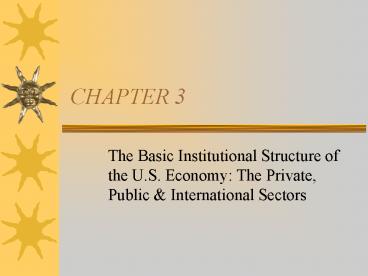The Basic Institutional Structure of the U'S' Economy: The Private, Public - PowerPoint PPT Presentation
1 / 26
Title:
The Basic Institutional Structure of the U'S' Economy: The Private, Public
Description:
The private sector is made up of independently owned firms that exist to make a ... Proprietorship (70% of all businesses with 5.8% sales) ... – PowerPoint PPT presentation
Number of Views:57
Avg rating:3.0/5.0
Title: The Basic Institutional Structure of the U'S' Economy: The Private, Public
1
CHAPTER 3
- The Basic Institutional Structure of the U.S.
Economy The Private, Public International
Sectors
2
The Private Sector
- Most production is undertaken by private
individuals and organizations.
3
The Private Sector
- The private sector is made up of independently
owned firms that exist to make a profit,
nonprofit organizations, and households.
4
The Private Sector
- The businesses set up to make profits may be
organized in one of three basic legal forms - Proprietorship (70 of all businesses with 5.8
sales). - Partnership (7 of all firms with 4.8 total
sales). - Corporation (20 of all firms with 90 of all
sales).
5
Group Discussion
- Identify specific companies that you know about
as belonging to one of the three basic legal
forms of private sectors.
6
The Organization of Industries
- An industry is a group of firms that produce
similar products.
7
The Organization of Industries
- The organization refers to how the industry is
structured. - How many firms there are.
- Whether the product is the same or
differentiated. - Whether or not firms can control prices or wages.
- Whether firms can enter or leave, or so forth.
8
The Organization of Industries
- Four categories are generally used to describe
the structures in the U.S.
9
Perfect Competition
- An industry in which many small firms produce
nearly identical (homogeneous) products.
10
Perfect Competition
- No single firm has control over prices and can
decide only how much output to produce and how to
produce it. - No barriers exist to block the entry of new firms
in search of profits, and exit is also easy.
11
MONOPOPY
- An industry in which only one firm produces a
product for which there are no close substitutes.
12
MONOPOPY
- The firm sets the price, but can only sell
whatever quantity the market will buy at that
price. - To remain a monopoly the firm must keep others
out by using barriers to entry - For example exclusive license from the government.
13
Monopolistic Competition
- A hybrid organization.
- There are many small firms (like perfect
competition) but each produces a slightly
different product.
14
Monopolistic Competition
- If the firm can differentiate its product enough
to establish a brand loyalty, it can enjoy some
of the benefits of monopoly. - Firms can compete by both price and quality, and
entry and exit are relatively easy.
15
Oligopoly
- An industry in which there are a few firms.
- In some cases one large firm dominates.
16
Oligopoly
- In other cases a few large firms have roughly
equal power. - Firms must consider the reactions of the other
firms when considering strategy. - Entry is difficult because of the large initial
investment is required to break into the industry.
17
THE PUBLIC SECTOR Taxes Government Spending
- The public sector plays a major role in
determining the allocation of resources, the mix
of outputs, and the distribution of rewards.
18
THE PUBLIC SECTOR Taxes Government Spending
- The size of the public sector can be measured as
a percentage of the nations total annual output
(GDP). - In total the public sector has almost doubled in
about the last 50 years, with the fed portion
increasing more rapidly than the state and local.
19
Government Spending
- Government spending can be broken into three
major categories - 1. Purchase of goods and services
- This includes wages salaries of govt. Employees
- 2. Transfer payments
- Cash payments made directly to households e.G
social security benefits - 3. Interest payments
- Paid to those who own government bonds
20
Government Spending Continued
- Government expenditures include spending on
national defense, health care, education, etc.
21
Government Spending Continued
- The social security payments and pensions for
government employees (including military) are
included in the transfer payment category. - Federal government interest payments on its debt
to individual bondholders counts as a service
payment, not as a transfer payment.
22
Sources Of Government Revenue
- The largest single source of government revenue
is individual income tax. Other sources include - 1. Social insurance taxes or payroll taxes.
- These pay for social security, disability, and
unemployment compensation.
23
Sources Of Government Revenue
- 2. Corporate income taxes.
- 3. Excise taxes.
- Taxes on specific commodities such as cigarettes,
alcoholic beverages, gasoline, etc.
24
Field Project Assignment
- Investigate how much of the price of a pack of
cigarettes is actually tax. - How does this vary by state?
- Do likewise with alcohol gasoline.
25
The International Sector
- In a closed economy there would be no
transactions with the rest of the world . - The U.S. Economy is by no means closed There are
thousands of transactions every day.
26
The International Sector
- The volume of trade increased significantly since
1970. - The composition of trade is tremendously
diversified.































